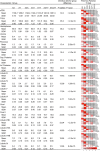Allometric Analysis Detects Brain Size-Independent Effects of Sex and Sex Chromosome Complement on Human Cerebellar Organization
- PMID: 28314818
- PMCID: PMC5456105
- DOI: 10.1523/JNEUROSCI.2158-16.2017
Allometric Analysis Detects Brain Size-Independent Effects of Sex and Sex Chromosome Complement on Human Cerebellar Organization
Abstract
The cerebellum is a large hindbrain structure that is increasingly recognized for its contribution to diverse domains of cognitive and affective processing in human health and disease. Although several of these domains are sex biased, our fundamental understanding of cerebellar sex differences-including their spatial distribution, potential biological determinants, and independence from brain volume variation-lags far behind that for the cerebrum. Here, we harness automated neuroimaging methods for cerebellar morphometrics in 417 individuals to (1) localize normative male-female differences in raw cerebellar volume, (2) compare these to sex chromosome effects estimated across five rare sex (X/Y) chromosome aneuploidy (SCA) syndromes, and (3) clarify brain size-independent effects of sex and SCA on cerebellar anatomy using a generalizable allometric approach that considers scaling relationships between regional cerebellar volume and brain volume in health. The integration of these approaches shows that (1) sex and SCA effects on raw cerebellar volume are large and distributed, but regionally heterogeneous, (2) human cerebellar volume scales with brain volume in a highly nonlinear and regionally heterogeneous fashion that departs from documented patterns of cerebellar scaling in phylogeny, and (3) cerebellar organization is modified in a brain size-independent manner by sex (relative expansion of total cerebellum, flocculus, and Crus II-lobule VIIIB volumes in males) and SCA (contraction of total cerebellar, lobule IV, and Crus I volumes with additional X- or Y-chromosomes; X-specific contraction of Crus II-lobule VIIIB). Our methods and results clarify the shifts in human cerebellar organization that accompany interwoven variations in sex, sex chromosome complement, and brain size.SIGNIFICANCE STATEMENT Cerebellar systems are implicated in diverse domains of sex-biased behavior and pathology, but we lack a basic understanding of how sex differences in the human cerebellum are distributed and determined. We leverage a rare neuroimaging dataset to deconvolve the interwoven effects of sex, sex chromosome complement, and brain size on human cerebellar organization. We reveal topographically variegated scaling relationships between regional cerebellar volume and brain size in humans, which (1) are distinct from those observed in phylogeny, (2) invalidate a traditional neuroimaging method for brain volume correction, and (3) allow more valid and accurate resolution of which cerebellar subcomponents are sensitive to sex and sex chromosome complement. These findings advance understanding of cerebellar organization in health and sex chromosome aneuploidy.
Keywords: cerebellum; development; genetics; neuroimaging.
Copyright © 2017 the authors 0270-6474/17/375222-11$15.00/0.
Figures






References
-
- Ad-Dab'bagh Y, Einarson D, Lyttelton O, Muehlboeck S, Mok K, Ivanov O, Vincent R, Lepage C, Lerch J, Fombonne E, Evans A (2006) The CIVET image-processing environment: a fully automated comprehensive pipeline for anatomical neuroimaging research. Paper presented at the 12th Annual Meeting of the Organization for Human Brain Mapping, Florence, Italy, June.
-
- Bellott DW, Hughes JF, Skaletsky H, Brown LG, Pyntikova T, Cho TJ, Koutseva N, Zaghlul S, Graves T, Rock S, Kremitzki C, Fulton RS, Dugan S, Ding Y, Morton D, Khan Z, Lewis L, Buhay C, Wang Q, Watt J, et al. (2014) Mammalian Y chromosomes retain widely expressed dosage-sensitive regulators. Nature 508:494–499. 10.1038/nature13206 - DOI - PMC - PubMed
Publication types
MeSH terms
LinkOut - more resources
Full Text Sources
Other Literature Sources
